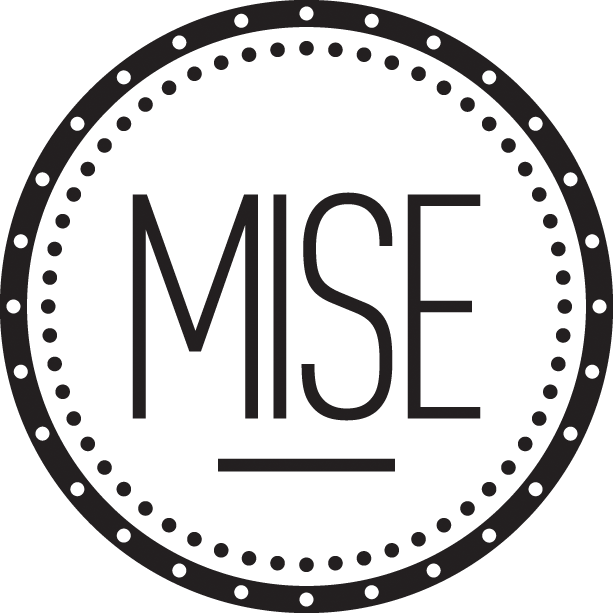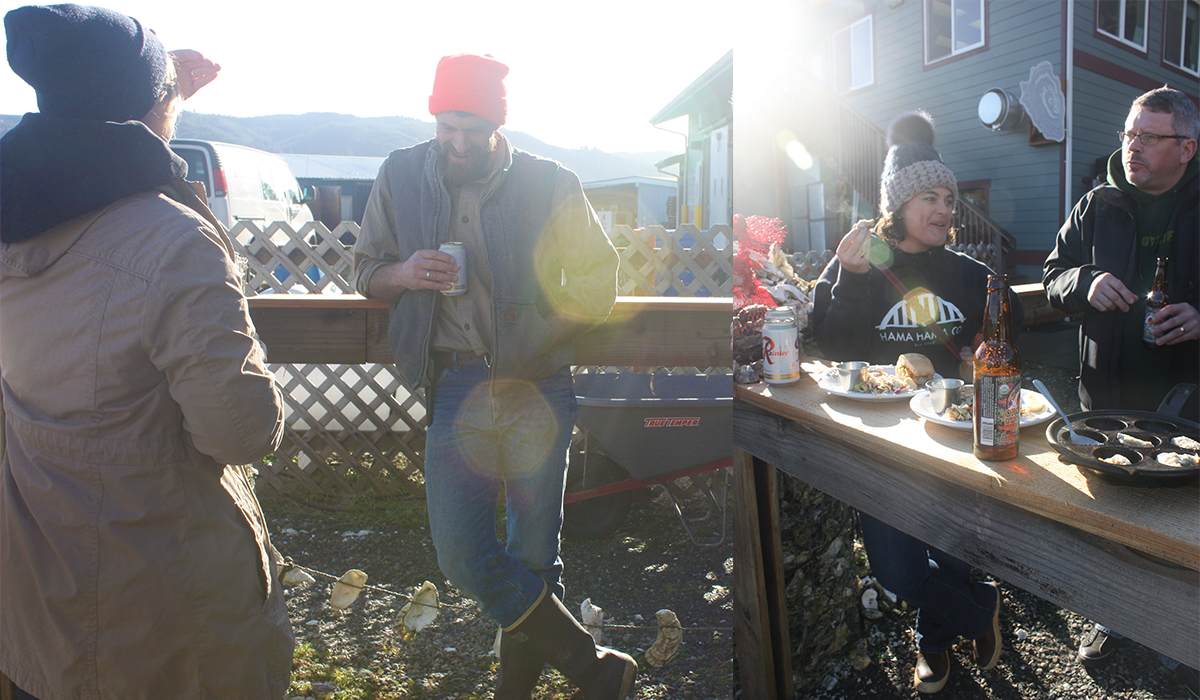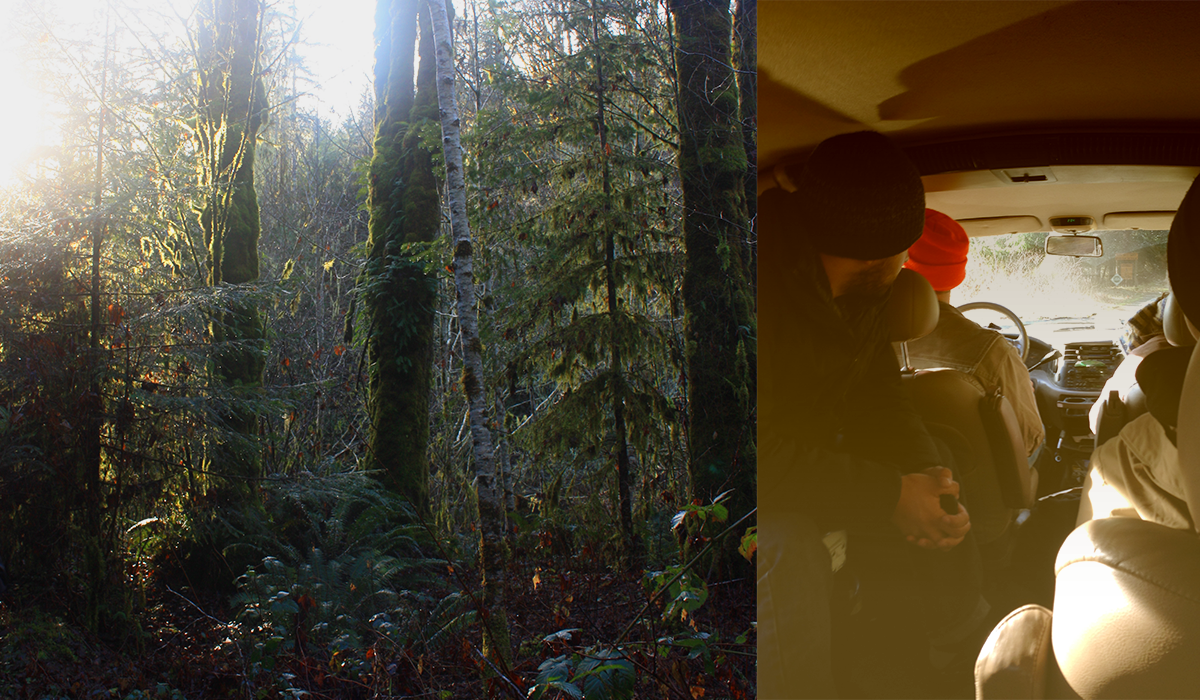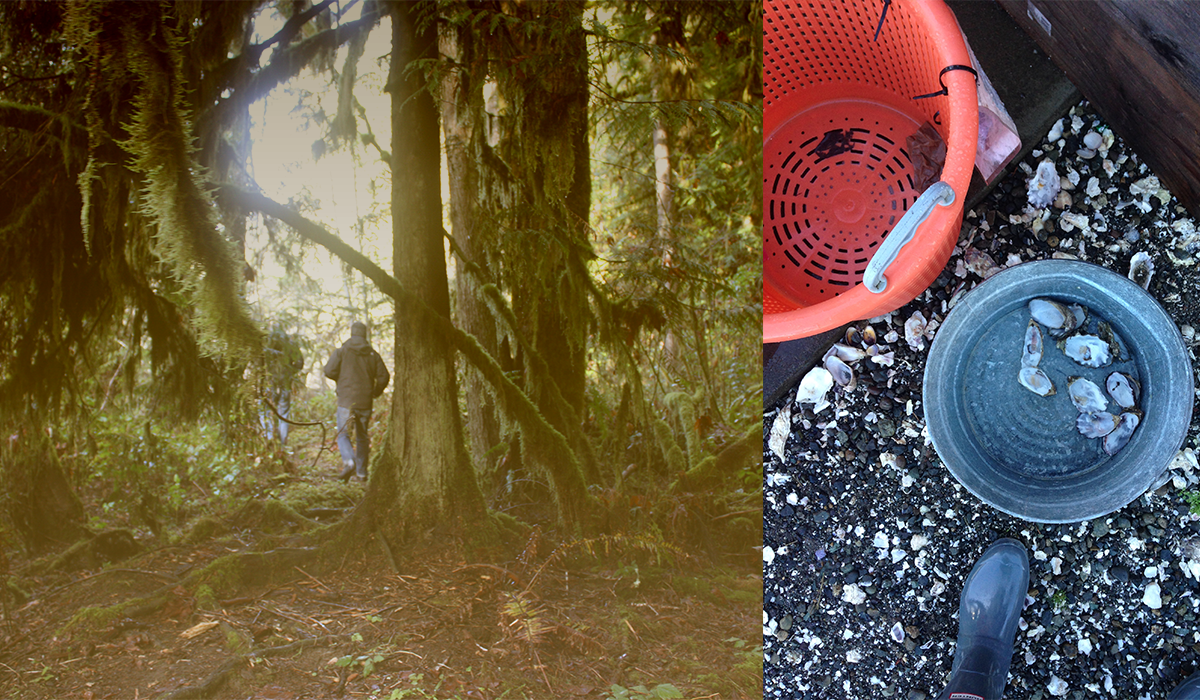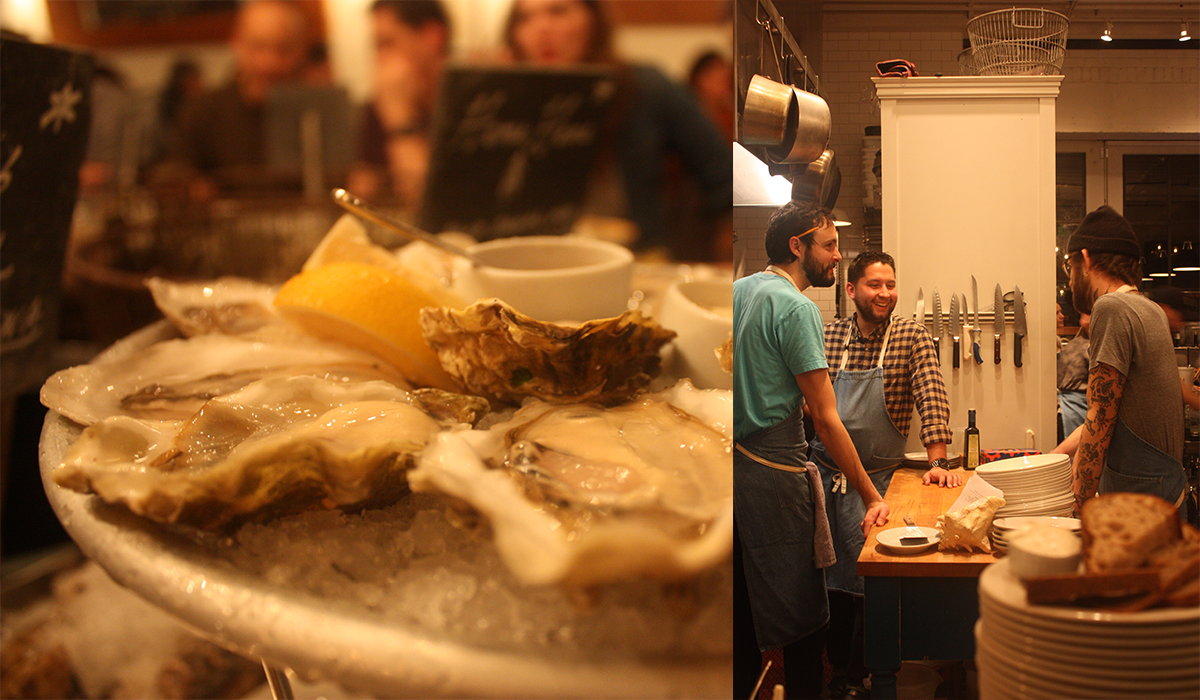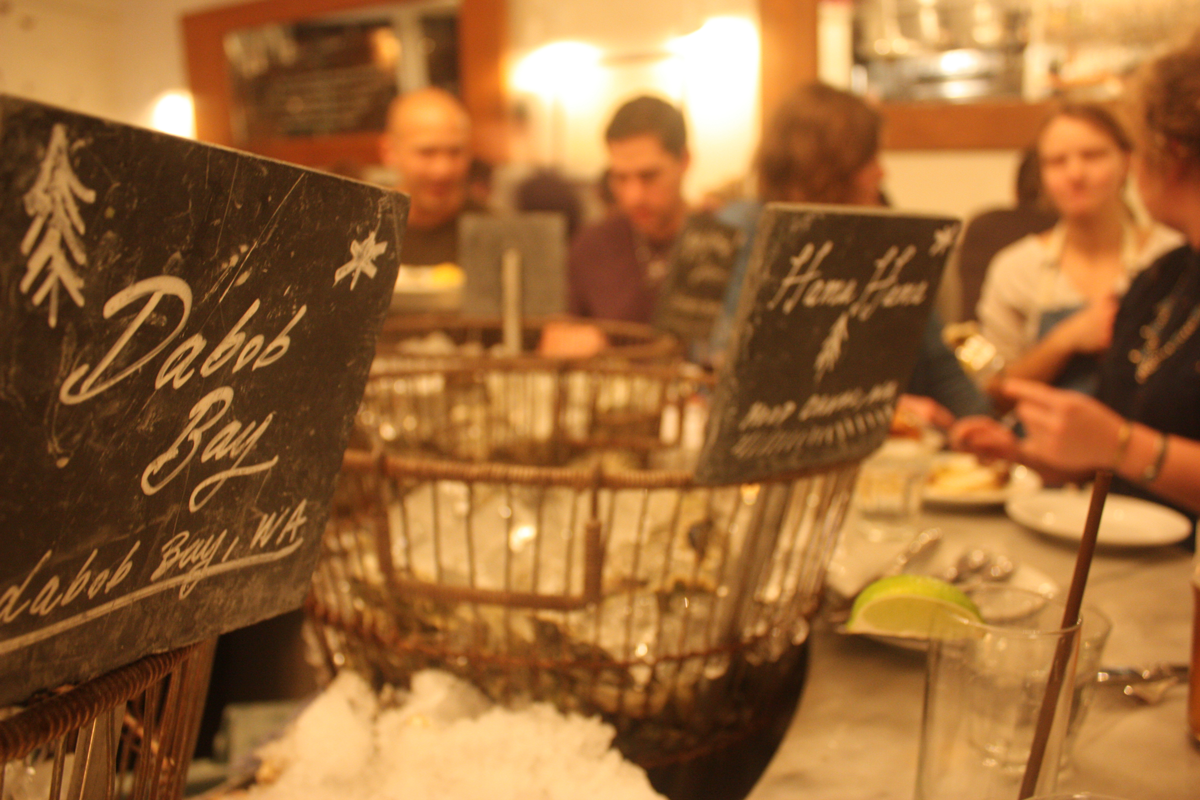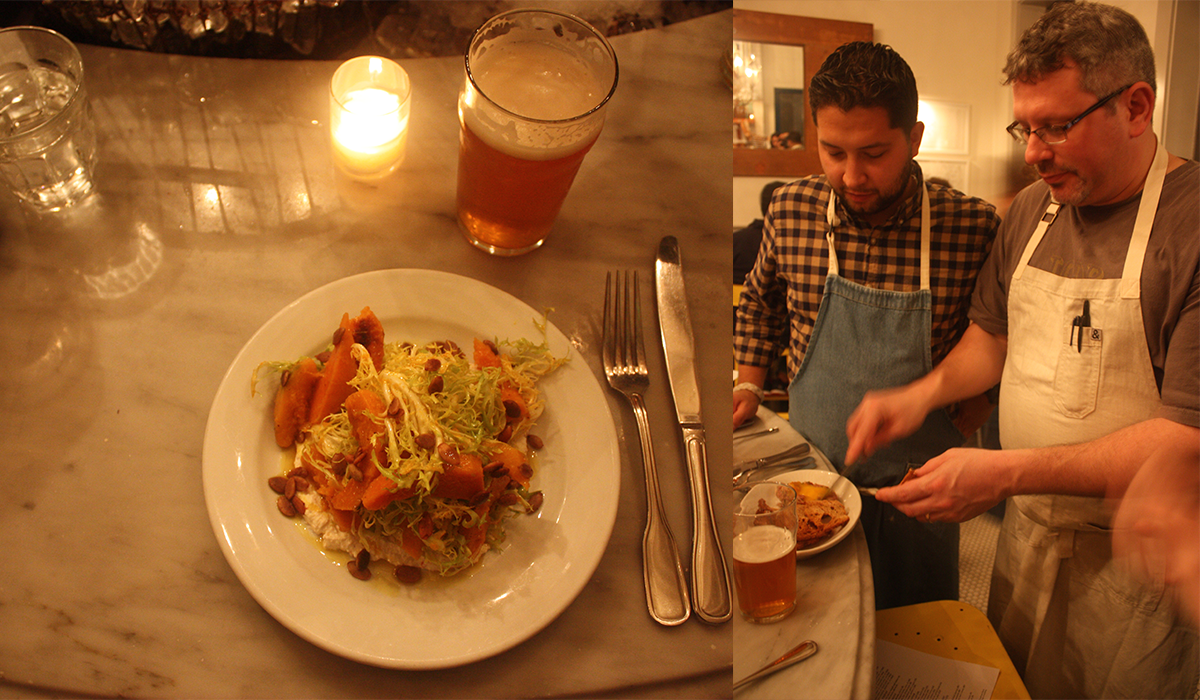Feature
Words & Photos by Cassandra Landry
2.18.2015 | Issue #11
“I just want to cook again,” Jeremy Sewall says. “I was a really good cook. That’s what made me successful...when you get away from that, you become a bystander.”
He’s perched on a chair in a small cabin a few yards from the shore of the Hood Canal, a just-cracked can of Olympia in hand. A few logs pop and spit sparks from the hearth, warmth slowly beginning to seep through the room. The dwindling afternoon sun streaming through the windows makes the neon orange beanie on the head of Adam James—oysterman, manager of the Hama Hama Company, and keeper of this cabin—light up like a beacon fire from where he stands at the kitchen counter.
“The thing about this day and age is you have to have a fuckin’ killer product,” James muses. “That’s what weird about this industry right now, that I’m an oyster farmer and I’m worried about things like branding—”
“—and you just want to grow oysters!” Sewall says.
“Yes! It’s a crazy world, man,” James says. “I just want to get better at what we’re doing.” Sewall nods, slow and emphatic, like this is the truest thing he’s ever heard.
No one assumes he is a bystander. As the creative nucleus of a handful of restaurants beloved to New Englanders, Bostonians in particular—Lineage, Island Creek Oyster Bar, and Row 34, with another outpost on the way—he has a hand in many, many different pots. He’s hesitant to attribute his many successes to anything other than an old-fashioned, salt-of-the-earth work ethic, and will bat any attempt at flattery politely away in favor of talking about how great everyone around him is. He’s come to Washington because he has written his first book, The New England Kitchen, and though press tours for this kind of thing are usually fueled on self-promotion and Sharpie-stained fingertips, you wouldn’t know it to look at him. He has so far spent his first-ever hours in Seattle contentedly shucking oysters behind the bar at Renee Erickson’s runaway hit The Walrus and the Carpenter, and hightailing it into the remote wilds of the Pacific Northwest to a place he feels truly at home: an oyster farm. (He was the very first chef to ever visit Duxbury, Mass.’s Island Creek Oysters, a product with which he is now synonymous.)
Because of the amount of inevitable paper-and-people-shuffling that comes with being that nucleus, he now gets fidgety when he goes three or four days without being in a kitchen. Being the boss is never quite how they tell you it’s going to be, and as he sits in this cabin, the thing they keep coming back to is a return to essentialism. How, in the maelstrom of the everyday, do you satisfy your creative self? The crux of it, James posits, is that you build an organization on charisma, but then have to introduce bureaucracy to manage it. “Managing the bureaucracy, the values there and the goals, become their own ends, versus whatever made you really great to begin with,” he says. “All of a sudden, you have a different set of goals, and a different set of performance standards to meet all of these different expectations.”
Sewall’s goals may not have changed in the 15 years since he was first nominated as a Rising Star Chef by James Beard (cook simply, and with passion), but the expectations certainly have. “It’s instant now, and that’s what really sucks,” he says. “I think it takes a restaurant at least a year, sometimes two, to really find itself. It’s a living, breathing thing, but now, you’re judged the second you open the door. You have to deliver.”
Delivering, for both of these men, and for Erickson—who’s currently hurling shells, bleached white by the sun, along the beach for her dog, Arlo—means creating a quality experience around the culture of the oyster, the signpost where all of their lives intersect. They don’t just sell the product, it’s woven into their identity.
“To get to know an area, to go through a couple harvest cycles and seasons...there’s a lot to be said for that,” James says. “And it’s about being in the right place at the right time. Twenty years ago what we’re doing wouldn’t be possible. It’s still oysters, but the techniques and the extra care that’s put into this product is much more consistent. I need to get what’s happening there because I’m trying to produce something for the people going to your oyster bar.”
The chefs (and the teams manning their lines while they’re here) get it because it distills for them the point of this industry: to serve great food. What draws everyone in at the start is the handling of something pure, and the fantastical vision for diving deeper and deeper into that experience. Going straight to the source, watching as the oysters are plucked straight from the water, secures them to that foundation. As new projects and red-tape and HR/PR blossom up around them, there is always this.
Erickson and Sewall’s assistant Carol return from the beach, noses red from the crisp January air. Arlo is suitably drenched and remains on the porch, his warm dog breath fogging up the glass door. “Do we have enough light to get up to Blue Pool?” Erickson asks, and suddenly everyone’s up and moving again, the stillness of the last moments fading away.
Blue Pool is both the Hama Hama family’s favorite swimming hole and the namesake of one of it’s most popular oysters. It’s tucked away in the heart of the mountain, so the group piles into a rough-and-tumble maroon minivan with James at the wheel, Erickson riding shotgun. Francisco Millan, chef de cuisine at Row 34, is balanced on a blue Coleman cooler instead of a seat, latched on to the driver seat headrest with one hand. Sewall, not a fan of heights, is in the back, eyeing the increasingly steep drop-off to the left side of the car. Errant branches scrape against the doors, and stones rattle in the wheel wells as the van jolts over the uneven path. There’s a cheery sticker of Smokey the Bear, fuzzy with age, on the back window.
James, probably to distract from the fierce climb, embarks on epic tales of farm life. Calf-birthing, elk-hunting, mountain-gazing. As he delivers his final punchline, the van lurches into a small clearing.
“I felt like I had something to say about New England, and this was the way to do it. It’s a great way to show what we do and who we are.”
Almost twelve hours prior to that rollicking van ride in Lilliwaup, Sewall is at his book party, sipping an IPA and watching the crowds at The Walrus and the Carpenter. After Erickson celebrated the launch of A Boat, A Whale, & A Walrus at Row 34 back in October, the two agreed to swap places when Sewall headed out on the road. After they had both penned love letters to their respective regions, as he puts it, and released them on the same day, how could they not? The Walrus is billed as an elegant iteration of local fishing pub; Row 34 a workingman’s oyster bar. “It was nice to spoil Renee while she was in Boston,” he says, digging into a plate of fried oysters with cilantro aioli that she’s sent out. “She obviously has such an affection for this style of restaurant, like we do. There are so many common threads, so it was easy to want to show her everything we could.” It's a time-honored mi casa es su casa industry handshake that comes so effortlessly to those who have lived it.
All of Seattle seems to have an affection for this style of restaurant, if the robust line of patrons waiting at the doors at go-time is any indication. “There’s always a line by 4:30,” a passing server explains, “and oyster orders just come flooding in, leaving Dave”—he nods at the guy behind the bar in a flannel who’s been knocking down tickets with Sewall since the start of the night—”to just shuck his life away.”
“There’s lots of worse things you could do!” Sewall says, watching Dave flip another oyster out of the pile without skipping a beat. They’ve got different shucking styles, which is striking when they’re working alongside each other; Sewall, because of the shallow cups of Island Creek varietals, tends to shuck on a flat surface to preserve as much of the liqueur as possible. The oysters of the Pacific Northwest, at least the ones consumed by the thousands at the Walrus, typically have deeper cups: as long as he’s fast, Dave can hold the oyster in his left and dig into the hinge with his right, flicking the flat shell away with the tip of his knife without losing much juice. Millan is in the kitchen chatting with Bobby Palmquist, CDC to CDC, and Erickson swings by to make sure everyone is eating. When everyone assures her they are, she nods, satisfied. “I’m a food pusher,” she says, tucking her curly black hair behind her ears. “We all are, it’s in our DNA,” Sewall grins, knocking back the rest of his beer.
He spots a couple flipping through the book and heads over to say hello and kiss the proverbial baby. “Writing a book is like having a kid. You can describe it to someone, but you don’t know until you do it,” he says. “It was much harder than I thought it was going to be. I thought I’d write recipes on the weekend or in the morning...yeah, no. You just have to sneak away and turn your phone off. I spent more time in the library as an adult than I ever did as a student.”
So why did this chef, who yearns for a return to the simplicity of the kitchen, choose to write a book, or open yet another restaurant? Why juggle another flaming machete? For him, The New England Kitchen, and by extension the tour (lovingly dubbed #tnekgoeswest on social media), serves to crystallize that very desire. It gives concrete page-value to the real star, the food, and elevates the work of the people he surrounds himself with. Writing a book may have been as much a personal benchmark as a career one, but Sewall's insistence upon helping younger cooks flourish means providing them with successful spaces to do so.
“As you get older, you have different priorities. The goal is not to achieve, necessarily,” he says. “It’s just to open great restaurants and work with great people and be proud of what you do. There’s always a little competitive edge to it, but I’ve gotten more confident over the years.” He looks at the book like he hasn’t quite realized it’s his own yet. “I love food, and I love restaurants. If you think about it too hard you go cross-eyed.”
The smell of moss—clean, cold, loamy—floods the van as the side doors slide open.
It’s everywhere; hanging from branches in seafoam-hued sheets, spreading like shag carpet over rocks and slick waterlogged tree trunks. It rained yesterday, and the ground still gives underfoot like memory foam. Everyone grabs a fresh trail beer and disappears into the green.
Though navigating with a beer in one hand proves challenging, Millan only loses a kitchen clog once, and the narrow sloping path eventually opens up to reveal a small island rising from the destination: Blue Pool. Everyone scrambles to the top of a boulder for the 360-degree view, hands reaching out and hoisting up, phones coming out in short-lived attempts to capture the grandiose. The turquoise water seems to ripple languidly on forever. For a while, no one is concerned with anything else but marveling.
Weeks later, after the tour has taken them down through Portland and San Francisco and Nashville, when Sewall is back in Boston, shoveling—“I’m not kidding, there’s five feet of snow in my yard,” he says over the phone—he will count this moment, and the ones afterwards when James packs everyone back in the van to point out the best spots to pick chanterelles, as a highlight of the trip. There’s an immediacy and a truth to the vibe at Hama Hama, something fizzing in the air that assures you life can be as simple as harvesting shellfish in the moonlight, all bourbon and fish tacos and good people around campfires. Even if James worries about branding, or about which oyster Erickson can sell to her guests, or if Sewall is underwhelmed by paperwork and minutia, “the love is always there to grab back onto,” Sewall says. “It’s hard to spend that much energy and time and effort pushing yourself, but at some point, you have to trust in the process.”
The appeal of essentialism, especially when applied to a creative endeavor—the pursuit of doing more by doing less—is undeniable. But the truth is, that love for food and raw talent that made Sewall great in the beginning? It’s the very thing that after a decades-long career, allows him to make others exceptional. By doing more, he’s able to deepen his impact on the ecosystem in which he lives and works; working alongside Millan during his move from Island Creek Oyster Bar sous to opening CDC of Row 34 is a perfect example. “We’re creating a culture of people that have a standard and a level of knowledge that they’ve gotten through working with us, and there comes a time when they need to move forward on their own,” he says. “We need to step back and let that happen.”
Here, in the depths of the Olympic National Forest, miles and miles and a ferry ride away from anything resembling a dinner rush, Sewall is anything but a bystander.
